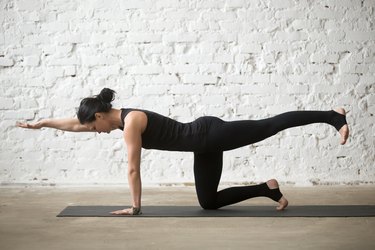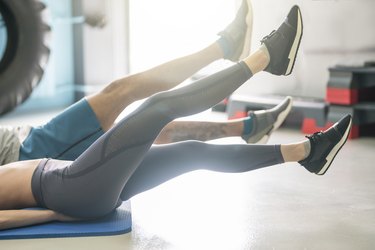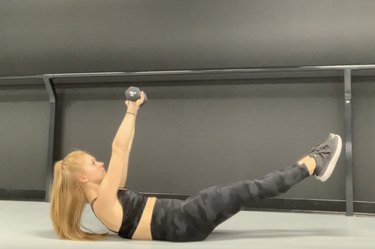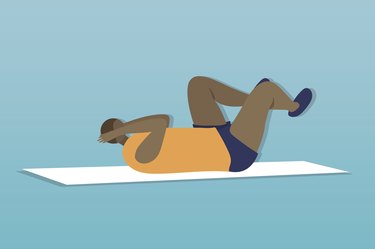
A dog may be a human's best friend, but the bird dog exercise is your core's best friend.
The aptly-named move (the position resembles a pointing hunting dog) is probably one of the most underrated ab exercises, considering its benefits go far beyond core strength. Perfect your form and learn why this exercise deserves a spot in your workout routine.
Video of the Day
- What is a bird dog exercise? Also called quadruped, it's an ab exercise you do on all fours, extending one arm in front of you and the opposite leg behind you, returning to center and repeating on the other side. It's performed slowly and with precision, focusing on activating the stabilizers in the front and back of your trunk.
- What muscles do bird dogs work? The move works your obliques, glutes, hamstrings and back.
- Who can do the bird dog? All fitness levels — in fact, everyone should do some variation of this exercise, says Sara Nickoles, ATC, a certified athletic trainer at Life Time in Maryland. However, if you experience any pain or discomfort with this move, it's best to stop doing it and talk with medical professional.
- What are bird dogs good for? This exercise builds strength in the small stabilizing muscles in your core and back. It also helps improve your overall mobility and range of motion.
How to Do the Bird Dog With Perfect Form
Bird Dog

- Get on your hands and knees with your hands directly in line with your shoulder and knees in line with your hips.
- Look down at the floor and brace your core (tucking your tailbone just slightly) to create a straight line from the tip of your head to your tailbone.
- On an exhale, reach your left arm straight out in front of you until your upper arm is in line with your ear.
- Simultaneously reach your right leg straight behind you, fully extending your knee.
- Pause here for a moment.
- Reverse the motion and return to the starting position.
- Switch sides, reaching your right arm forward and raising your left leg back.
- Pause and then go back to the starting position.
Tip
Imagine balancing a glass of water on your back throughout the exercise to help keep your back flat and body as stable as possible.
Watch the Full Tutorial
7 Tips for Better Results
1. Stay Steady
One common mistake when doing the bird dog (aka quadruped) is rocking from side to side. When you do this exercise, you want the only things moving to be the arm and leg you're raising, explains Brad Whitley, DPT, a California-based physical therapist. As you lift your opposite arm and leg, your torso should stay as still as possible. This helps you target your core and back stabilizing muscles.
Think about keeping your core braced and neck long if you feel your body starting to sway. Or, try a modified version that involves lifting only your arms or only your legs (more on those below).
2. Square Your Hips
Another error people often make is allowing their hips to rotate as they lift their leg, according to Carolina Araujo, CPT, a California-based strength coach. With each rep, you may notice your hips opening up in the direction of your moving leg. But you actually want both sides of your pelvis facing the ground at all times.
Slow the movement down to help keep your hips level, she says. Before you lift your legs, actively think about your hips' positioning, making sure they're squared to the floor.
3. Look Straight Down
When you do this exercise, you want to create a line from the top of your head to your tailbone, Whitley says. This helps keep your back and neck safe as you move. To make sure your neck stays flat, keep your eyes down on the ground between your palms.
4. Pull Your Shoulders Away From Your Ears
When people raise their arms over their head, they often bunch their shoulders up around their neck and ears, Araujo says. But this can add unwanted pressure on your neck and makes it harder to do the exercise with good form.
With each rep, think about pulling your shoulder blades back and down. Not only does this protect your joints, it gives you more space to move your arms.
5. Make One Long Line
This is not a donkey kick or superman, Araujo warns. Don't raise your leg or arm any higher than your back. Doing so will result in you arching your back. That'll keep your core muscles from being able to fully engage and also stress your spine.
Don't fret. You don't need to raise your leg or arm very high at all to benefit from this exercise.
Raise up so that your heel and fingers are in line with spine and your body forms one long line, she says. "You don't need to go higher than that. Film yourself on your phone to check your form." (You might be surprised to find you're kicking higher than needed.)
6. Keep Your Shoulders Over Your Wrists
Most of the time, when people say the bird dog feels easy, it's because they're accidentally cheating. The most common cheat is leaning your weight back toward your hips and out of your arms.
Throughout the entire exercise, keep your shoulders forward and directly over your wrists (or where you'll lower your hands with each rep). This transfers some of your body weight to your arms and is what ultimately forces your core to work.
7. Protect Your Wrists
For some people, leaning too much weight into their wrists can feel uncomfortable and even painful.
If that's the case for you, Whitley recommends you make two fists and put them on a squishy mat or foam pad on the ground, leaning into the tops of your fingers instead of your palm. This puts your wrist in a neutral position, which is usually more comfortable for those with sensitive joints.
Alternatively, you can hold onto two hexagonal dumbbells with a palms-in grip. This will keep your wrists in a straight position as well.
4 Bird Dog Exercise Benefits
1. Better Warm-Ups
One thing bird dog exercises are good for? Muscle activation! Nickoles loves using them at the beginning of her workouts to help wake up the muscles needed for her exercises later on, like her core, hips and glutes.
Don't underestimate the power of a good warm-up. By prepping your muscles before you start training, you set yourself up for success during your workout, according to a July 2017 study in the BMJ Open Sport & Exercise Medicine. That means stronger performances, better results and a lower risk of injury.
2. A Stronger Core
Although it may not look like some of the other ab exercises you do, the quadruped builds plenty of core stability, according to Whitley. By keeping your trunk stable as you move your limbs, you build control of your deep core muscles, also known as your transverse abdominis (TA).
TA strength translates to a lot of your other gym exercises or daily activities. Essentially, this deep core muscle works like an internal weight belt, supporting your lower back when you lift a barbell off the ground or pick up a heavy box.
3. Increased Back Strength
Alongside its ab-building benefits, the quadruped exercise is a back strengthener, too, Whitley says. But this move goes beyond the aesthetic muscles, focusing instead on the deep back muscles such as your erector spinae, rotatores and multifidus.
These are all small but important stabilizing muscles that protect your spine and support great posture, which explains why many physical therapists recommend the bird dog for scoliosis.
No matter your current posture or back health, giving these muscles a little extra attention can help keep you injury-free.
4. Improved Range of Motion
For many people, lifting their arms straight above their head is no easy task. Although this is a natural movement pattern, it demands a lot of range of motion. Practicing exercises like bird dogs can help you gradually build your shoulder mobility and motion, Whitley says.
This move also improves your back mobility, which is a pain point for many people, considering they spend a majority of their day seated with bad posture. As you raise your arms, you open up your chest and extend your spine, which helps improve the motion of the muscles in your back.
2 Bird Dog Modifications to Make It Easier
Move 1: Arms-Only Bird Dog
- Get on your hands and knees with your hands directly in line with your shoulder and knees in line with your hips.
- Look down at the floor and brace your core (tucking your tailbone just slightly) to create a straight line from the tip of your head to your tailbone.
- On an exhale, reach your right arm straight out in front of you until your upper arm is in line with your ear.
- Pause here for a moment.
- Reverse the motion and return to the starting position.
- Switch sides, reaching your left arm forward.
- Pause and then go back to the starting position.
Tip
Sure, this is a beginner bird-dog exercise, but it's harder than it looks. To really engage and challenge your core, keep your shoulders directly over your planted wrist at all times.
Move 2: Legs-Only Bird Dog
- Get on your hands and knees with your hands directly in line with your shoulder and knees in line with your hips.
- Look down at the floor and brace your core (tucking your tailbone just slightly) to create a straight line from the tip of your head to your tailbone.
- On an exhale, reach your right leg straight out behind you until your heel is in line with your hip.
- Pause here for a moment.
- Reverse the motion and return to the starting position.
- Switch sides, reaching your left leg back
- Pause and then go back to the starting position.
Tip
Try to see how slowly you can raise and lower your leg with each rep.
4 Bird Dog Progressions to Make It Harder
Move 1: Bird-Dog Crunch
- Get on your hands and knees with your hands directly in line with your shoulder and knees in line with your hips.
- Look down at the floor and brace your core (tucking your tailbone just slightly) to create a straight line from the tip of your head to your tailbone.
- On an exhale, reach your left arm straight out in front of you until your upper arm is in line with your ear.
- Simultaneously reach your right leg straight behind you, fully extending the knee.
- Pause here for a moment.
- Reverse the motion and draw your left elbow to your right knee, giving your abdomen a crunch.
- Reach your left arm and right leg back out.
- Do 8 to 10 reps here, then switch sides.
Tip
This variation adds additional ab benefits by recruiting your rectus abdominis six-pack muscles.
Move 2: Single-Side Bird Dog
- Get on your hands and knees with your hands directly in line with your shoulder and knees in line with your hips.
- Look down at the floor and brace your core (tucking your tailbone just slightly) to create a straight line from the tip of your head to your tailbone.
- On an exhale, reach your left arm straight out in front of you until your upper arm is in line with your ear.
- Simultaneously reach your left leg straight behind you, fully extending the knee.
- Pause here for a moment, keeping your hips square to the ground.
- Reverse the motion and return to the starting position.
- Reach your right arm and right leg out, pausing for a moment.
- Return to the starting position.
Tip
This is an advanced progression that requires a lot of stability. If you find yourself leaning toward one side, keep practicing the other bird dog exercise variations here and come back to this one.
Move 3: Weighted Bird Dog
- Get on your hands and knees with your hands directly in line with your shoulder and knees in line with your hips. Hold a pair of light dumbbells in each with a neutral grip. (You can also ankle weights.)
- Look down at the floor and brace your core (tucking your tailbone just slightly) to create a straight line from the tip of your head to your tailbone.
- On an exhale, reach your left arm straight out in front of you until your upper arm is in line with your ear, holding the weight.
- Simultaneously reach your right leg straight behind you, fully extending the knee.
- Pause here for a moment.
- Reverse the motion and return to the starting position.
- Switch sides, reaching your left arm and weight forward, kicking your right leg back.
- Pause and then go back to the starting position.
Tip
For these, start really light on the dumbbells. A 3- to 5-pound dumbbell is more than enough. You can also use ankle weights, securing them around your wrists and/or ankles.
Move 4: Resistance-Band Bird Dog
- Loop one end of a long resistance band around your right palm.
- Loop the other end around the balls of your left foot.
- Get on your hands and knees with your hands directly in line with your shoulder and knees in line with your hips.
- Look down at the floor and brace your core (tucking your tailbone just slightly) to create a straight line from the tip of your head to your tailbone.
- On an exhale, reach your right arm straight out in front of you until your upper arm is in line with your ear.
- Simultaneously reach your left leg straight behind you, fully extending the knee.
- Pause here for a moment, resisting the band.
- Reverse the motion and return to the starting position.
Tip
In this exercise, the band makes the exercise harder as you stretch the band and raise up. Use a long looped resistance band that is just slightly taut at the bottom of the move.
Additional reporting by Jaime Osnato.
More Core Exercises
Was this article helpful?
150 Characters Max
0/150
Thank you for sharing!
Thank you for your feedback!


